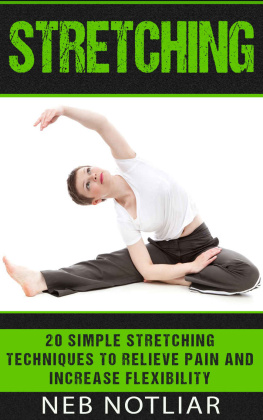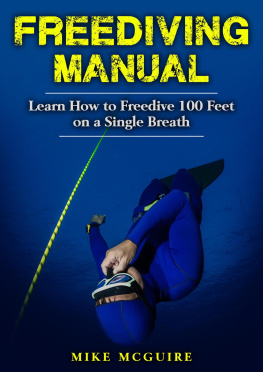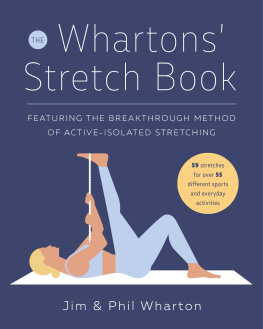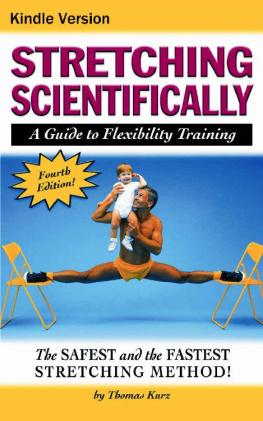Cover
STRETCHING FOR FREEDIVING
A 4-Week Beginners Training Plan to Increase Flexibility, Dive Deeper & Hold Your Breath Longer.
By Gert Leroy
Copyright 2020 Gert Leroy
All rights reserved
No part of this book may be reproduced, or stored in a retrieval system, or transmitted in any form or by any means, electronic, mechanical, photocopying, recording, or otherwise, without express written permission of the publisher.
Contents
INTRODUCTION
W hats up guys? Great to see you have decided to commit to this 4-week training plan!
For those who don't know me, my name is Gert Leroy. I help you master freediving.
This document is a training plan to stretch the muscles that are responsible for our breathing. The more flexible they become, the better youll be able to control your breathing, hold your breath longer, and dive deeper.
This training plan is the result of my own experience as a freediving instructor working with students. It puts emphasys on simple but effective stretches that will make you considerably more flexible in a matter of only a couple of weeks.
Just follow the program outlined and go through each week as described below and the results are yours. Good luck and enjoy!
WHY STRETCH?
O k, so why should you stretch for freediving? Well, first of all, stretching for general purposes is always a good thing. Stretching increases flexibility, increases range of motion, increases blood flow to the muscles & helps to heal and prevent back pain. Its also a great stress reliever and a perfect way to start your day.
So what are the specific benefits of stretching for freediving? When your respiratory muscles become more flexible, youll be able to:
control your breathing better
take a bigger breath
equalize better (yes thats right!)
cope better with the pressure as you dive deeper
Sounds good right?
WHAT TO STRETCH?
O k, so now you get the idea. So which are the respiratory muscles that have to be stretched?
First of all you want to make sure you stretch the body for general health, overall flexibility, and good functioning. That includes stretching of the back (spine), the hips, legs, shoulders and arms.
Here are the body parts we want to specifically stretch for freediving:
Diaphragm: controls the volume of air we take into our lungs: When you breathe in, the diaphragm lowers to make space for the lungs to expand. When the diaphragm goes back up, we exhale air out of the lungs. The more flexible the diaphragm, the more range of motion, and the more air we can take into the lungs.
Ribcage / intercostal muscles (thoracic stretching): The ribcage is a container for the lungs. The more it can expand, the more the lungs can expand, and the more air they can contain. A more flexible ribcage will allow you to take a bigger breath. In order for the ribcage to be flexible, we want to stretch the intercostal muscles, which are the muscles in between the ribs.
Spine / lower back: A healthy and flexible spine is the core of a healthy body. In modern life, we are constantly bent forward, looking at our screens, or sitting at a desk. A healthy spine will result in good posture and prevent injury. Spine twists will stretch your ribcage, and open up your chest and shoulders.
Shoulders: In disciplines like constant weight with monofin or bifins, and even in the no fins discipline, freedivers hold the arms extended above the head. This requires good shoulder flexibility. If you have rigid shoulders, youll have a hard time keeping your arms extended, in one line with the body. The more flexible the shoulders, the more streamlined your position.
Head / neck: As equalization of the ears requires total relaxation of the body, and especially of the muscles in the neck area (where are the eustachian tubes responsible for equalization), you want to gently stretch those muscles as well.
WHEN TO STRETCH?
S o now that youve got that figured out, you want to know when is the best moment to stretch. Well, i recommend you doing this first thing in the morning (on empty stomach) or before going to bed (also on empty stomach).
The duration of a session is about 10 minutes, so its a small investment into your daily schedule. Please stick to your routine on every day of the week, except on sundays you can take a break from stretching.
If you have a dive session scheduled, you can stretch before so your muscles are already warmed up when you go into the water.
A good point to remember is that flexibility is a result of consistent daily stretching, and a single stretch session right before a dive session isnt gonna make the difference.
HOW TO STRETCH?
Y ou want to be gentle to your body, especially in the first week, when you still have to get used to the different stretches. Dont go to the point of feeling pain. The idea is to enjoy the session, and apply mild to moderate stretching. Pay attention to how it feels.
Each stretching exercise comes with a duration. E.g. 15 means 15 seconds continuous. And 2x30" means 2 sets of 30 seconds, with a pause in between the sets.
All stretches are static, unless it is indicated as dynamic. Static means you keep on holding the stretch for the given time. E.g. 2x30 shoulder stretch means 2 sets of 30 holding the shoulder stretch. Dynamic however means were not gonna hold the pose. Were going from left to right and back in a continuous mode. E.g. side bends arms down (dynamic) 1 means 1 minute of continuous left and right bending.
Keep on breathing with regular pace during the stretches. Your breathing should be calm and controlled at all times. Give you body and mind the necessary time to adapt throughout the program.
The last 2 exercises of each session are always a variation on the backbend with gymball and the uddiyana bandha. Those two could be described as most specific stretches for freediving, so your daily 10 minute session is build in such a way that you are finishing off with the cherry on the cake.
Equipment:
For this training plan youll need:
a yoga mat
a gym ball (stability ball)
a bar to hang on (optional)
For stretching equipment please click here:
https://kit.co/gertleroy/stretching-equipment
MISTAKES PEOPLE MAKE










